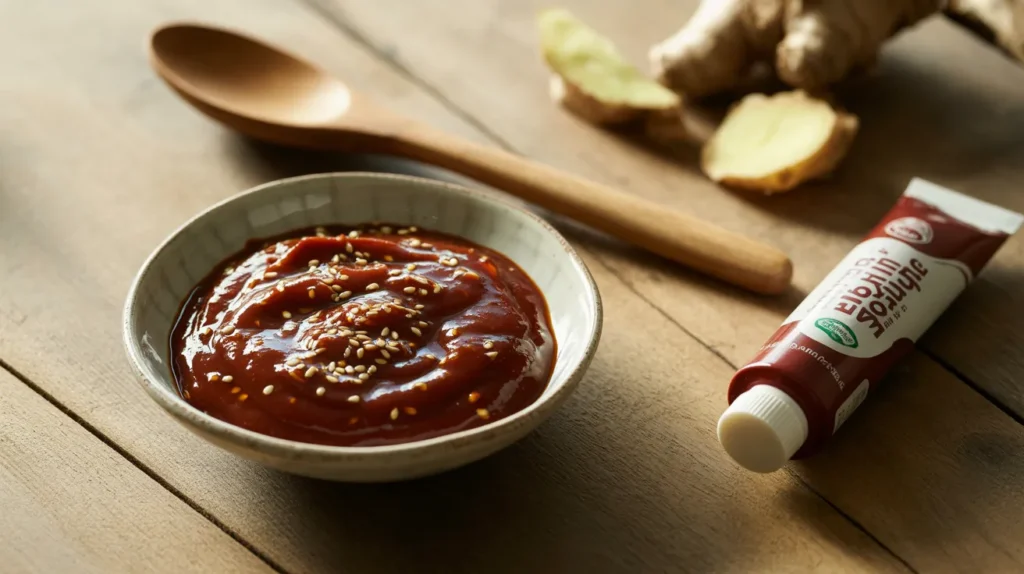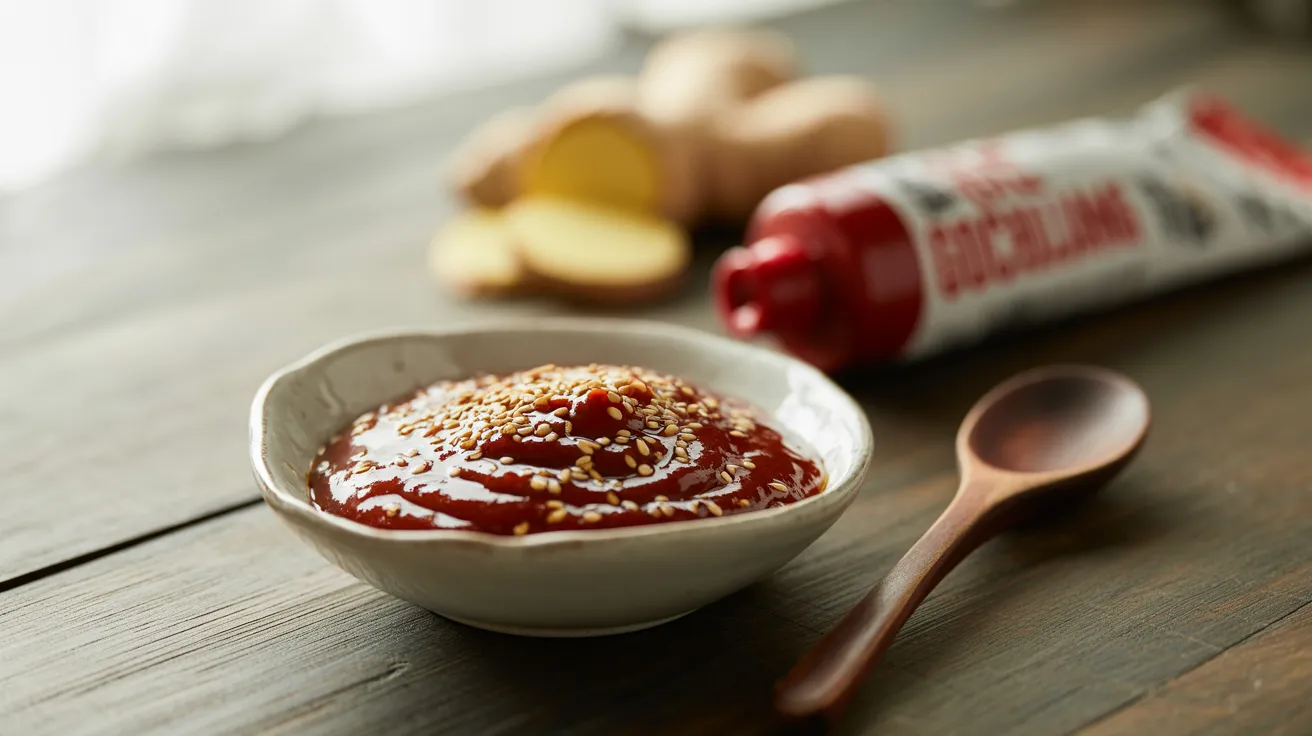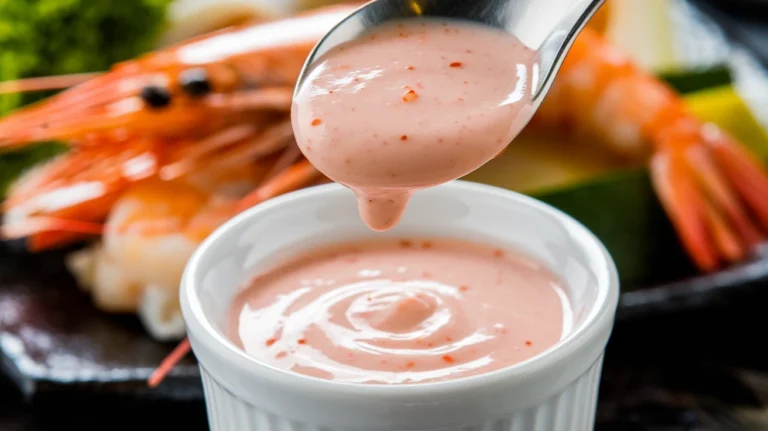Key Takeaways:
- This Gochujang Sauce recipe takes just 15 minutes with simple ingredients
- Perfect balance of sweet, savory and spicy flavors anyone can make
- Stores for up to 3 weeks in the refrigerator
- Versatile sauce for rice bowls, marinades, and dipping (serves 4)
Why Your Kitchen Needs Gochujang Sauce Today
Ever tried making Korean dishes at home only to find they lack that restaurant-quality taste? The missing piece is likely a proper Gochujang Sauce. This vibrant Korean chili sauce balances sweet, savory, and spicy notes that transform ordinary meals into extraordinary dishes.
Homemade Gochujang Sauce gives you complete control over heat levels and ingredients. Unlike store versions with preservatives and excess sodium, this recipe creates a fresh, authentic sauce that serves 4 people generously with enough for multiple meals.
Nutrition Facts for Gochujang Sauce
| Nutrient | Amount per Serving |
|---|---|
| Calories | 78 |
| Total Fat | 2g |
| Sodium | 380mg |
| Carbohydrates | 15g |
| Sugar | 10g |
| Protein | 1g |
Essential Ingredients for Gochujang Sauce
Complete Ingredient List
| Ingredient | Measurement | Notes |
|---|---|---|
| Gochujang paste | 3 tablespoons | The base of your sauce |
| Rice vinegar | 2 tablespoons | Provides acidity |
| Honey or maple syrup | 2 tablespoons | Adds sweetness |
| Soy sauce | 1 tablespoon | Delivers umami flavor |
| Sesame oil | 1 teaspoon | Creates richness |
| Minced garlic | 1 teaspoon (about 2 cloves) | Adds aromatic depth |
| Minced ginger | 1 teaspoon | Provides warmth |
| Toasted sesame seeds | 1 teaspoon | For texture and visual appeal |
| Water | 2-3 tablespoons | Adjusts consistency |
Required Kitchen Tools
| Tool | Purpose |
|---|---|
| Small mixing bowl | For combining all ingredients |
| Measuring spoons | For precise measurements |
| Whisk | For smooth blending without lumps |
| Rubber spatula | For scraping bowl sides |
| Airtight container | For proper storage |
| Garlic press (optional) | For easily mincing garlic |
| Grater (optional) | For ginger and garlic |
Potential Substitutions
- Gochujang paste: This is the essential ingredient with no perfect substitute, but in emergencies, mix 1 part sriracha with 1 part miso paste
- Rice vinegar: Apple cider vinegar (use 1½ tablespoons instead of 2 for less sharpness)
- Honey: Maple syrup (same amount) or brown sugar (use 1½ tablespoons)
- Soy sauce: Tamari for gluten-free option or coconut aminos for lower sodium (same amounts)
- Sesame oil: No good substitute for flavor, but peanut oil works for allergies
Beginner’s Guide to Making Gochujang Sauce
Preparation Phase (5-7 minutes)
- Clear your workspace and create a clean area with enough room to work.
- Wipe down counters to ensure cleanliness
- Have a damp cloth nearby for quick spill cleanup
- Position your recipe where you can easily read it
- Gather ALL ingredients before starting and place them in your work area.
- Check expiration dates on all ingredients, especially the gochujang paste
- Bring refrigerated items to room temperature for 15 minutes
- Measure each ingredient into separate small bowls if that helps you stay organized
- Prepare your fresh ingredients with care.
- For garlic:
- Peel each clove by pressing with the flat side of a knife
- Either use a garlic press OR
- Mince by hand by first slicing thinly, then rocking your knife back and forth until pieces are 1mm or smaller
- If you’re new to mincing, aim for pieces as small as a grain of rice
- For ginger:
- Peel a 1-inch section of ginger using a spoon’s edge to scrape the skin off
- Use a microplane grater for the easiest results OR
- Mince by hand using the same technique as garlic
- Measure AFTER mincing, not before
- Fresh ginger should smell fragrant and be firm to touch
- For garlic:
- Measure all remaining ingredients precisely.
- For sticky ingredients like honey and gochujang paste:
- Spray measuring spoons lightly with cooking oil first
- Use a small rubber spatula to scrape everything from the spoon
- For thin liquids like vinegar and soy sauce:
- Pour at eye level to ensure accuracy
- Place measuring spoons over your mixing bowl to catch any drips
- For sticky ingredients like honey and gochujang paste:
Mixing the Gochujang Sauce (8-10 minutes)
- Start with gochujang paste as your base.
- Add exactly 3 tablespoons to your mixing bowl
- Use a rubber spatula to get every bit from the measuring spoon
- The paste is thick and sticky – this is normal
- If it’s your first time using gochujang, smell it to become familiar with its aroma
- Add the liquid ingredients in this specific order:
- First, add rice vinegar (2 tablespoons)
- This begins to thin the thick paste
- Stir 5-6 times with the spatula
- Next, add honey or maple syrup (2 tablespoons)
- The sweetness balances the heat of the gochujang
- Stir another 5-6 times
- Then add soy sauce (1 tablespoon)
- This provides the salty element
- Stir until you see the mixture becoming more uniform in color
- First, add rice vinegar (2 tablespoons)
- Incorporate the flavor enhancers one by one:
- Add sesame oil (1 teaspoon)
- Pour slowly as it’s strong and a little goes a long way
- Notice the aromatic scent it adds to your sauce
- Add minced garlic (1 teaspoon)
- Spread it around rather than dumping in one spot
- This ensures even distribution of flavor
- Add minced ginger (1 teaspoon)
- Distribute evenly throughout the mixture
- The ginger adds a subtle warmth and depth
- Add sesame oil (1 teaspoon)
- Whisk everything together using proper technique:
- Hold the bowl steady with your non-dominant hand
- Start whisking slowly in the center of the bowl
- Gradually increase speed as ingredients combine
- Use a circular motion while also moving across the entire bowl
- Continue for 2-3 minutes until completely smooth
- Make sure to reach the edges and bottom of the bowl
- The color should be an even, rich red-brown
- No streaks of any individual ingredient should remain visible
- Adjust the consistency with water carefully:
- Start with just 1 tablespoon of water
- Whisk thoroughly after adding
- Check the consistency by lifting the whisk and seeing how the sauce drips off
- For thicker sauce (good for dipping), stop at 1-2 tablespoons
- For thinner sauce (good for drizzling), add up to 3 tablespoons total
- Add water in ½ tablespoon increments for precise control
- The ideal consistency is similar to ketchup or slightly thinner
- Add texture with sesame seeds:
- Sprinkle 1 teaspoon of toasted sesame seeds throughout
- Stir gently with a spoon to distribute
- Reserve a few seeds for garnishing when serving
- If your sesame seeds aren’t toasted:
- Heat a dry pan over medium heat
- Add seeds and stir constantly for 2-3 minutes until golden
- Let cool completely before adding to sauce
- Perform a taste test and make adjustments:
- Use a clean spoon to taste a small amount
- Assess the balance between sweet, spicy, and savory
- For more sweetness: add ½ teaspoon more honey
- For more heat: add ¼ teaspoon more gochujang paste
- For more tang: add ¼ teaspoon more rice vinegar
- For more richness: add a few more drops of sesame oil
- Always taste again after each adjustment
Final Steps (2-3 minutes)
- Transfer to storage container properly:
- Choose a clean glass jar or airtight container
- Use a silicone spatula to scrape every bit from the bowl
- Leave about ½ inch of space at the top of the container
- Wipe any sauce from the rim of the container before sealing
- Seal tightly to preserve freshness
- Label your Gochujang Sauce with:
- Name of the sauce
- Date prepared
- Expected expiration (3 weeks from preparation)
- Let flavors develop before using if possible:
- For best flavor, let the sauce rest at room temperature for 30 minutes
- This allows the garlic and ginger flavors to infuse completely
- The sauce can be used immediately if needed
- For even better flavor development, refrigerate overnight

Troubleshooting Your Gochujang Sauce
Problem: Sauce is too thick and won’t pour
- Solution: Add more water, ½ teaspoon at a time, whisking between additions until it reaches desired consistency
- Prevention: Remember that the sauce will thicken slightly when refrigerated
Problem: Sauce is too thin and runny
- Solution: Add more gochujang paste, ½ teaspoon at a time, whisking thoroughly
- Prevention: Always add water gradually and check consistency frequently
Problem: Sauce is too spicy for your taste
- Solution: Add more honey (½ teaspoon at a time) or a tablespoon of plain yogurt to mellow the heat
- Prevention: Start with 2 tablespoons of gochujang if you’re sensitive to spice
Problem: Sauce tastes too tangy or acidic
- Solution: Add ½ teaspoon more honey and a pinch of salt to balance the acidity
- Prevention: Use seasoned rice vinegar instead of plain for a milder tang
Problem: Sauce lacks depth of flavor
- Solution: Add a few more drops of sesame oil or ¼ teaspoon of fish sauce
- Prevention: Use fresh garlic and ginger, not pre-minced versions
Problem: Sauce separates during storage
- Solution: Simply stir or whisk well before using
- Prevention: Mix thoroughly during preparation and store in proper containers
Variations of Gochujang Sauce for Every Taste
Mild Gochujang Sauce
Replace half the gochujang with tomato paste for a milder version that’s still flavorful. This creates a gentler sauce similar to hoisin sauce but with a Korean twist.
Citrus Gochujang Sauce
Add 1 teaspoon of orange or lime zest and 1 tablespoon of juice for a bright, citrusy variation. The result offers a refreshing quality reminiscent of ponzu sauce.
Creamy White Gochujang Sauce
Mix your finished sauce with 2 tablespoons of Greek yogurt or sour cream for a tangy, creamy variation that’s excellent with fried foods, similar to Japanese tartar sauce but with a Korean kick.
Vegan Gochujang Sauce
Use maple syrup instead of honey. All other ingredients in this recipe are already plant-based.
Extra Umami Gochujang Sauce
Add ½ teaspoon miso paste or 1 teaspoon grated apple for additional depth of flavor.
Mayo-Based Gochujang Sauce
Mix your finished sauce with 2 tablespoons of mayonnaise for a creamy dipping sauce perfect for vegetables or fries.
Proper Storage of Gochujang Sauce
Refrigeration
- Store your Gochujang Sauce in an airtight container in the refrigerator
- Keeps fresh for up to 3 weeks when properly stored
- The flavors often deepen and improve after 1-2 days
Freezing Options
- Freeze in ice cube trays for convenient portions
- One standard ice cube = about 2 tablespoons of sauce
- Once frozen solid, transfer cubes to a freezer bag
- Label with name and date
- Keeps for up to 3 months in the freezer
- Thaw in refrigerator overnight before using
Before Using Stored Sauce
- Always stir well before using as ingredients may separate
- Bring to room temperature for 15 minutes for best flavor
- If sauce has thickened during storage, whisk in a few drops of water
- Always use clean utensils when dipping into the container
Safety Notes & Expert Tips
Food Safety
- Always use clean utensils when scooping sauce from the storage container
- Never double-dip or return unused sauce to the storage container
- If the sauce develops an off smell, unusual color, or mold, discard immediately
- Keep refrigerated except when in use
Beginner Tips for Success
- Measure ingredients precisely for consistent results
- Gochujang brands vary in spiciness – Korean brands like Chung Jung One and Sempio are reliable
- Look for gochujang in Asian markets, international grocery sections, or online
- Start with less gochujang if you’re uncertain about spice levels
- The sauce will thicken slightly when chilled
Best Uses for Gochujang Sauce
- As a marinade: Coat proteins for at least 30 minutes before cooking
- As a glaze: Brush onto meats during the last 5 minutes of cooking
- As a dipping sauce: Serve with dumplings, vegetables, or chicken
- As a flavor booster: Stir 1-2 teaspoons into soups or stews
- As a sauce base: Mix with mayonnaise for a spicy sandwich spread
Perfect Pairings for Gochujang Sauce
Your homemade Gochujang Sauce pairs wonderfully with:
- Bibimbap (Korean rice bowls)
- Grilled meats like bulgogi
- Roasted vegetables
- Stir-fried noodles
- Tofu dishes
- Fried rice
- Chicken wings
- Steamed dumplings
Now you have a foolproof Gochujang Sauce recipe that will elevate your home cooking to restaurant quality. The vibrant color and bold flavors make this sauce a versatile addition to countless dishes. With just 15 minutes of preparation, you’ll create a sauce that transforms simple meals into memorable Korean-inspired feasts!




